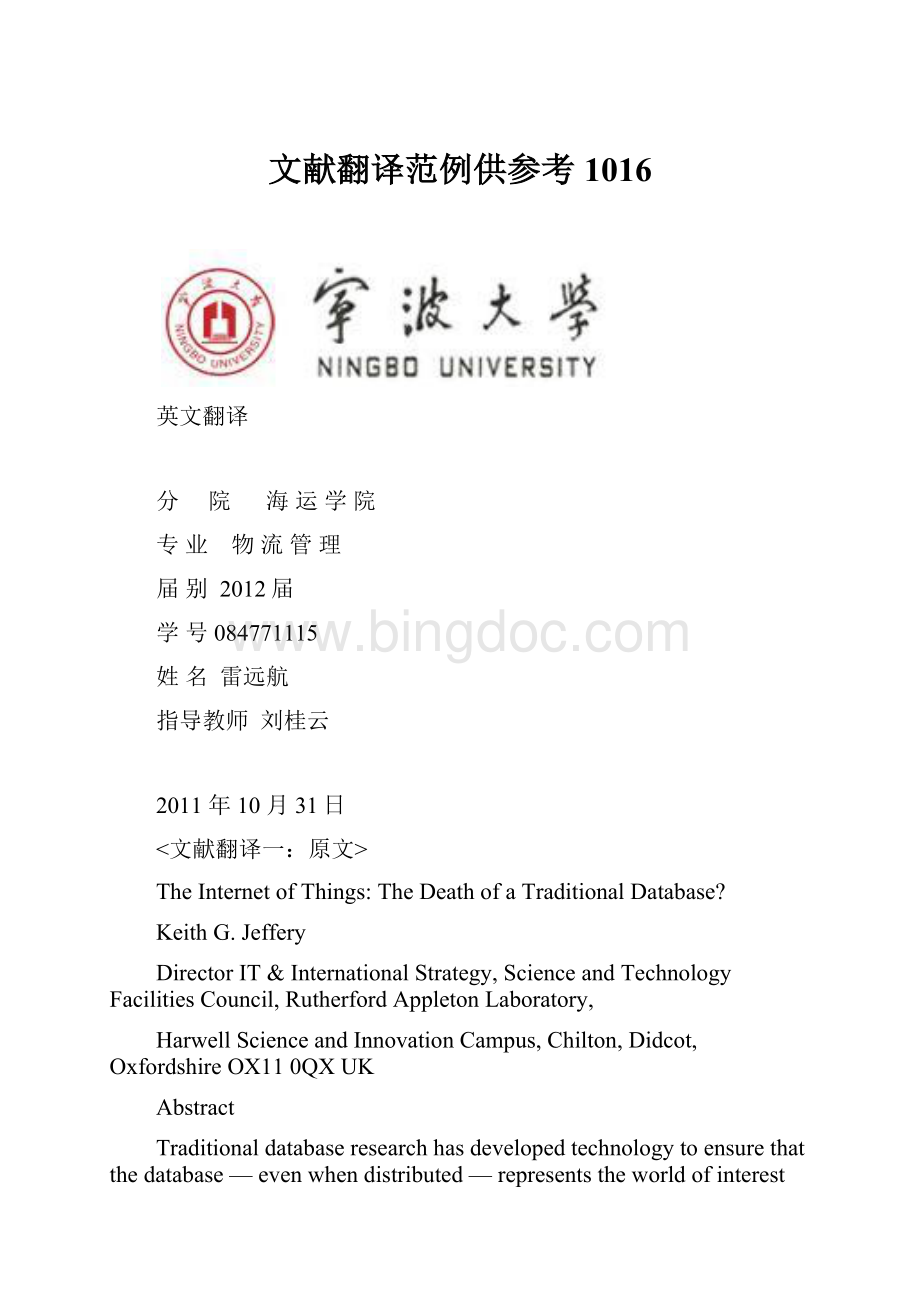文献翻译范例供参考1016Word下载.docx
《文献翻译范例供参考1016Word下载.docx》由会员分享,可在线阅读,更多相关《文献翻译范例供参考1016Word下载.docx(20页珍藏版)》请在冰点文库上搜索。

分 院 海运学院
专业物流管理
届别2012届
学号084771115
姓名雷远航
指导教师刘桂云
2011年10月31日
<
文献翻译一:
原文>
TheInternetofThings:
TheDeathofaTraditionalDatabase?
KeithG.Jeffery
DirectorIT&
InternationalStrategy,ScienceandTechnologyFacilitiesCouncil,RutherfordAppletonLaboratory,
HarwellScienceandInnovationCampus,Chilton,Didcot,OxfordshireOX110QXUK
Abstract
Traditionaldatabaseresearchhasdevelopedtechnologytoensurethatthedatabase—evenwhendistributed—representstheworldofinterestwithintegrityandaconsistentstate.Importantconceptshavebeendevelopedandproven.However,theinternetofthingschallengesallthis.Verylargenumbersofnodeshandlevolumesthatarevast,thespeedisfastandthedata/informationspaceisglobal—indeedwithspacedata—universal.Thisposeschallenges.Whatdoestheconceptofastatemeanwhentheinformationmapoftherealworldofinterestisrepresentedacrossmillionsofnodes,manyofwhichareupdatinginreal-time?
Whatdoesatransactionlooklikewhenthedatabeingupdatedisspreadacrosshundredsorthousandsofnodeswithdifferingupdatepolicies?
Worse,howdoesonerollbackorcompensateatransaction?
Wehavealreadyseendatabaseresearchappliedtosemi-structureddata,tostreameddata,andreal-timeapplications.Isitpossibleforthesetechniquestobeappliedtotheinternetofthings?
Theinternetofthingsopensupmoreopportunitiesforsecuritycompromises.Howdowedeveloptrustbandsecuritytechniquesacrossmultiplepolicies?
Howdowepreventtheunauthorizeduseofprivateinformationyetpermitauthorizeduse?
Weneeddynamictrust,security,andprivacymanagement.Doweneedanewtheoreticalframework?
Keywords
Database,Futureinternet,Integrity,Process,State,Transaction,Workflow.
1.Introduction
ThereismuchactivityinEuropeandtheworldonpredictingthefutureofinformationandcommunicationtechnology(ICT).ThereareroadmappingexercisesforRandDinvariousdomainstomeetthatpredictedfuture.TheEChassetupexpertgroupsand/orProjectscoveringGRIDs,CLOUDs,Service-OrientedArchitectures,quantumandbio-computing,newmaterials,human‑computerinteraction,andcognitivetechnologyamongothers.ThereismuchdiscussionofWeb2.0andbeyond.The‘InternetofThings’(http:
//en.wikipedia.org/wiki/Internet_of_Things)isastrongthemewitharecentEC(EuropeanCommission)conference(May2009)dedicatedtoit.TheformationoftheFIA(FutureInternetAssembly)underpinsthegroundswellofenthusiasmforthisidea,andIssue77ofERCIMNews[1]hasFutureInternetTechnologyasthespecialtheme,withaforewordbyVivianeReding,ECCommissionerforInformationSocietyandMedia,emphasizingtheimportance.Europeisestablishingane-InfrastructureandtheUSisestablishingitsCyberinfrastructure.
Databaseresearchers(withafewnotableexceptions)havenotbeenveryprominentinthesediscussions.Thisissurprising,asthemovementtowardtake‑upofthesenewtechnologiesbythebusinessworldpioneeredintheresearchfieldwillrequire,attheleast,interoperationwiththeexistingdatabasetechnology,andmostlikelyafurtherwholesaleevolutionaryorrevolutionarydevelopment
ofthedatabasetechnology,toadapttothenewenvironment.Databaseresearchhasmovedtoincludesemi-structureddataanditsprocessingandmanagingofdatastreams.Thereisworkonschemamatchingandmappingforinteroperation(sometimesinthecontextofDataspaces),andondomainontologies.Thereisstillongoingworkonweb-databaseinterfaces,modeling,andsystemsdevelopment.Workonperformanceorqueryoptimizationwithnewalgorithmscontinues,asdoesoptimizedstoragearchitecture—includingP2P(PeertoPeer).
Wherearetheadvancesindatabaseresearchmatching—and/orcontributingto—thehugeadvancesin(amongothers)socialnetworking,contentcreationandrepurposing,gaming,sensorsystems,robotics,autonomicsystems,visualization,userinteraction,systemsandsoftwaredevelopment,andservice-orientedarchitecture?
2.AVision
Thevisionhasitsrootsin[2]withsubsequentrefinements[3,4]leadingtoananalysisandsynthesisperformedin2008andupdatedin2009byERCIM(www.ercim.org).ItisbasedonthearchitectureproposedfortheUKe-Scienceprogram[2]andisrepresentedinFigure1.
Letusimagineapossiblestatein20years’time.TheproblemsfacingEurope—andtheworld—(fromcontinentthroughcountrytoindividualpersonscale)arelarge,complex,andrequireunprecedentedscientific,mathematical,andITskillsfortheirsolution.
Thereisafast,reliable,inexpensivee-infrastructureprovidingallcommunicationservices.Personsareconnectedtothee-infrastructureviapersonalcomputerdevicesthatarecontinuouslyonline.Thenetworkingcomponentsofthee-infrastructureinvisiblyprovideoptimalconnectivityintermsofperformance,reliability,cost,andsecurity.Thee-infrastructurephysicallysenses,detects,records,andcurateseverything,usingallthecomputers,storagedevices,networks,andsensors.Subjecttosecurity,privacy,ownershipandcommercialrightsallcomputational,storage,detector,andcommunicationfacilitiesareavailabletoeveryone.Detectorsandsubsystemswilloccurinallenvironments,acrossallindustriesandsocialservices,asalsointhehomeenvironment.Subsystemsareembeddedwithinthee-infrastructure—forexamplecontrolsystemsforutilities—includingpersonaltransport.Othersubsystemswillberoboticforagriculture,manufacturing,healthcare,andotherapplications.Thise-infrastructurevisionhasmajorimplications:
1.Thereisacontinuingandacceleratingneedforeverfaster,smaller,cheaper,andmoreenergy-efficient(andlessheat-producing)devices.Atsomepointbiologically-inspiredsystemswilldominateandwillcompete/cooperatewithquantum-basedtechnologies.
2.New‘intelligentmaterials’willbedeveloped,whichwillallowartifactstobeconstructed‘internet-ready’.Thesewillrangefromagriculturalproductsthroughtomanufacturedproducts.
3.Theopenavailabilityofeverythingsimplifiesthephysicalaccessandimprovestheperformance,
Includingreducinglatency,butwilldemandever‑increasingperformance,scalability,reliability,andself-management.
4.Themiddlewareofthee-infrastructurebearsheavyresponsibilities:
(a)forprovidingtheself‑*characteristics(self-managing,self-tuning,self-repairing)ofareliablee-infrastructure;
(b)foridentification,authorization,trust,security,privacy,andaccesscontrol;
(c)forhidingthecomplexitythroughvirtualizationandabstraction,thusprovidinghomogeneousaccesstoandutilizationofheterogeneousfacilities.
Thei-infrastructurereliesontheunderlyinge-infrastructureandconvertsthedata(structured,semi-structured,andunstructured)toinformation.Thei-infrastructureprovidestheprocessingcapabilitiestocollect,structure,manage,describe,andmanipulatetheinformation.Itprovidescomputationalmodeling/simulationfacilitiestogeneratenewinformation.TheprocessingcapabilitieswillbeService-OrientedKnowledgeUtilities(SOKUs)whicharediscoverable/composableanddynamicallytunable,basedonpropertiesdescribedbytheirmetadata.ThereisamassiveAmountofcontent:
Fromstructuredverifieddataandinformationthroughtopersonallyauthoredsocialnetworkingartifacts,andfromdatastreamsgeneratedbydetectorsthroughtoentertainmentandeducationmaterial.Thevolumesofdataandinformationwillprecludeshippingdatatoprocessorswithappropriatesoftware;
ratherweshallneedtoshipsoftwaretothedata.
Thek-Infrastructuremanagesknowledge;
allowingdifferingsemanticdescriptionsoveraformalsyntaxinthei-layer.Thisisthedomainwherehumansordataminingextractknowledgefrominformationbydeductionorinduction,wherethatknowledgeiscodifiedandstoredforuseinoptimizingthee-andi-layers,andforinterfacingtointelligentapplicationsandintelligentuserinterfacesintheoverlyingapplicationlayer.
Relyingonthise-,i-,andk-infrastructureareapplications.TheyalsowillbeconstructedfromSOKUs.TheSOKUswillhavefunctionalcharacteristicsandtheirnonfunctionalcharacteristics(includingperformance,security,anduse-conditionaspects)willbedeterminedbyawell-definedinterfacetothee-infrastructure.Sucharchitectureallowsextensivere-useofwell-triedcomponentsandtherapiddevelopmentofapplications,usingthemandadditionalnewservicesspecificallyforaparticularapplication.TheapplicationswillrangefromgamesandedutainmentthroughtoB2C(Business‑to‑customer)andB2B(business-to-business)transactionswithinanE2E(enterprise-to-enterprise)environmentandontoadvancedRandDactivities.Decision-makingwillbebasednotjustonstructuredinformationandknowledgeinductionanddeductionutilizinginformation,butalsoonsimulations.Theseapplicationswillbeavailable(underappropriateconditionsdeterminedbytherestrictivemetadata)toeveryone.Someapplicationswillbegeneralandwidelyapplicable—rangingfromentertainmentandgamesthroughcooperativeworking/socializingtoinformationmanagementandanalysis.Thesearelikelytobepre-composedandoptimizedforefficiency.Someapplicationswillbehighlyspecializedforparticularindustrial/commercialsectorsorforsocialsectorssuchashealthcareandenvironment;
thesewillbeconstructeddynamicallyatdemand-time.
Theend-userwillinteractwiththeapplicationsviaasetofpersonalizeddevices—includingrobots—providingservices.Eachdevice-basedservicewillhaveassociatedrole-basedprofiles(meta